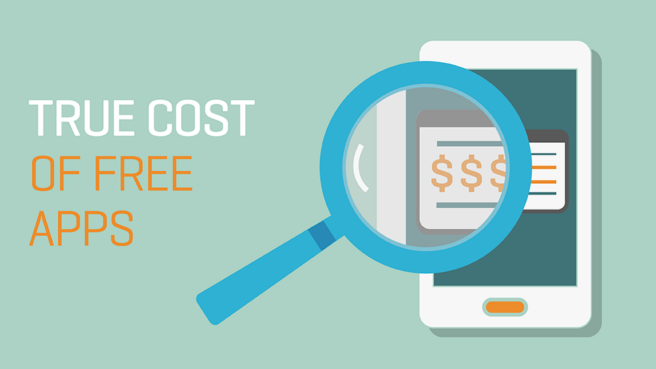What is the true cost of 'free'?

We’re all used to downloading apps onto our phones and tablets – today’s users have the choice to download from millions – 2.2 million on Android and more than 2 million in Apple’s App Store. However licensing them becomes complex when we start to use those said same apps not just for our personal use but in our professional lives.
We need to start understanding that naivety is no excuse, it’s all in the end user license agreement which are not just screeds of yada yada – in fact they contain strict guidelines on how apps should be paid for if used in daily business life.
BOUNDARIES
Exactly where does the boundary lie between free and paid? What happens to BYOD and COPE devices in terms of compliance? It’s complex. Often companies discover that users have innocently downloaded apps that they are now liable to pay licensing fees for.
Here’s a few typical examples that we, and our customers, (that our customers have come across when either adding mobile devices to Snow License Manager or by combining Snow License Manager with Snow Device Manager) have come across:
Creative Cloud: Download one or more of the ‘free’ Adobe apps onto a device for corporate use and you will have to pay. Download two or more when working in a larger company and the user will lock the company into a three-year enterprise agreement.
Office Mobile: Office is free for you to use on your smartphone or tablet if, and only if, you are not using it for commercial purposes [and] you are not performing advanced editing. Commercial use requires a commercial subscription to Office 365. Furthermore a mobile device is defined by its screen size – over 10.1” and the user has to pay an enterprise license for the app by default.
iTunes: In downloading apps if you are using the same Apple ID on your iPad and iPhone, then the app will appear on both devices – beware that some vendors will count this as two licenses
Oracle and SAP: They will sting you for a license if you access a payroll app via a mobile device whether directly or indirectly. The rules that apply are the same rules as for browsers, laptops and desktops, so nothing has changed, except for users bringing a multitude of possibly unknown devices.
Dropbox: Beware of using your corporate e-mail when signing up for free private services – if colleagues share documents via Dropbox, by using their work email when they sign up for the service, they should have a paid-for corporate account starting at €12 a month per user which can quickly add up to a tidy sum that you hadn’t budgeted for.
Fitbit: Encouraging its users to be active, one enterprise provided discounts on Fitbits for its staff. But by syncing to corporate mobiles and laptops this breached the End User License Agreement and ironically the organization then had to block the app from all corporate-owned devices.
Pokemon Go: Since the app relies on GPS and Google Maps, these have to be active for users to play, which gives rise to a number of challenges, in particular data roaming costs and battery life – as the phone risks quickly running out of charge. Another risk is that due to the game’s popularity many third party applications have been published where users think they are downloading the game but in fact are downloading malware.
WHAT’S THE SOLUTION?
Avoiding these pitfalls would be a good start. With Mobile SAM you can get visibility of what mobile apps users have downloaded so at least you can start to understand your compliance position. With the greater controls afforded through an Enterprise Mobility Management solution such as Snow Device Manager there’s lots of ways to circumvent having to fork out large sums to vendors by ensuring from the outset that users are restricted on what apps they can and cannot download.
This can be achieved in a number of ways:
Blacklisting: Through blacklisting, administrators can block an app from being downloaded. In the case of two variants of an app being available, for example, users could be prevented from downloaded the ‘free’ one and only be able to access the paid-for (by the enterprise) version. Other can be blacklisted and preventing from downloading to a device.
Whitelisting: Here the enterprise can define and limit the apps that users can download to a device. If Dropbox isn’t listed then users would be blocked from creating and accessing Cloud storage on their devices.
WiFi: Restrictions can be placed on WiFi so that users cannot connect to WiFi works or switch on data roaming. Snow Device Manager can also force all data consumption through the company’s network and therefore traffic can be monitored or blocked.
Create a corporate app portal: Another way is to restrict users from accessing the public app stores, instead they could only access the enterprise app portal and download the apps they want from there.
With mobile use now ubiquitous across the workplace and boundaries converging between personal and corporate use, users don’t give a second thought about managing the apps on their phones. For them it’s about getting access to what they want at the point of need.
Today SAM managers need solutions where organizations can manage the mobile estate and ensure that license spend and app utilization is monitored and controlled to avoid unbudgeted spend on extra licenses. Snow Device Manager is the award winning mobile technology that can help you manage your mobile environment.
Book a test drive today to see the full potential of the technology and how it can benefit your organization!